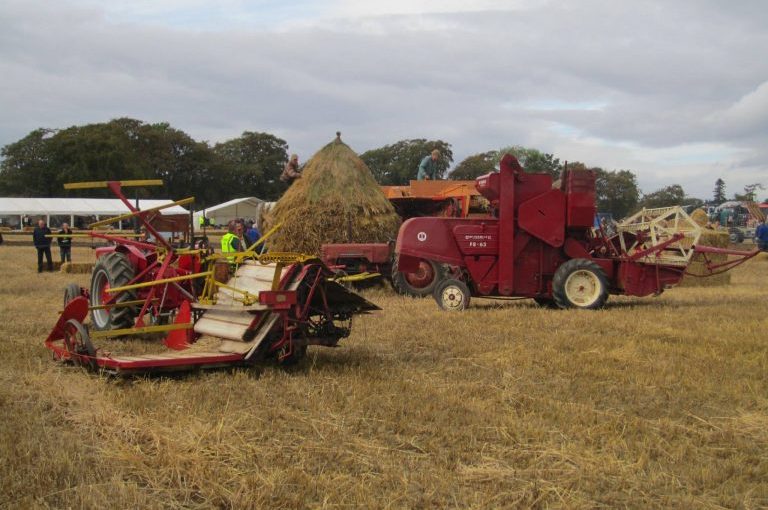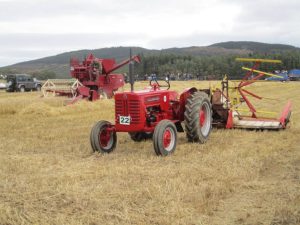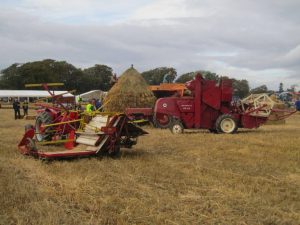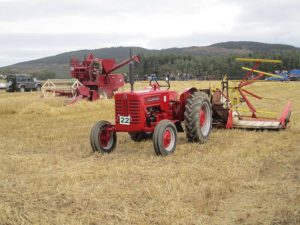The Royal Highland and Agricultural Society of Scotland played an important role in encouraging the development of agricultural implements and machines, exhibiting them and arranging trials and demonstrations of them. In the 1890s the Society also arranged working demonstrations. These were for binders. This was one of the only times in the history of the Society that it arranged demonstrations rather than trials. They were not competitive and awards were not given. They were arranged to give farmers and agriculturists the opportunity to see these machines at work.
These exhibitions were undertaken in different locations throughout the country. These were usually in the different show districts where the show was in attendance.
The following are a number of accounts of these exhibitions. They set out how the exhibitions were arranged, and describe how they worked in sometimes trying conditions with twisted and flattened crops.
Exhibition in Midlothian in 1893 (from Elgin courant and Morayshire advertiser, 22 August 1893)
“On Wednesday last an exhibition of binders at work was held under the auspices of the Highland and Agricultural Society at Niddrie Mains, Liberton, near Edinburgh. The exhibition was not a strictly competitive one. No awards were given, but a committee of gentlemen who acted as stewards made a report to the Society, in which they embodied their observations regarding the performances of the various machines that were at work. The committee consisted of Messrs Jonathan Middleton, Clay of Allan, Ross-shire; Geo. R. Glendinning, Hatton Mains; J. T. Paterson, Grange Loan, Edinburgh; and A. S. Logan, Fernie Castle, along with whom there was Mr Park, the Society’s engineer.
The following is the jurors’ preliminary report: “We have pleasure in reporting that we carefully watched the working of the eleven binders that came forward. They were in the first place tried in a field of oats which was cut into plots of one acre each. Lots were drawn by the competitors for the different plots, and care was taken to make the trial as even as possible to all. The oat crop was very rank, and badly laid and twisted. The test was therefore an exceedingly severe one. Indeed much of the crop was so badly laid and twisted that it seemed hardly likely that either the binder or the reaper could possibly make passable work in it. In these circumstances it is peculiarly gratifying to be able to say that upon the whole the work of cutting and binding was done in a satisfactory manner-better cut, most probably, than it would have been by the ordinary reaper. Very little fault could be found with either the cutting or binding. Most of the machines had difficulty in separating the one sheaf from the other, on account of the rank, tangled condition of the crop, yet, even in this respect, the majority of the machines did surprisingly good work. The crop could be cut only in the direction, and in most cases the work was slowly done. The plots in the field of oats having been finished, all the machines, excepting the “Jonson Harvester”, was tried in an adjacent field of barley. The crop of barley was not rank, but it was much laid and twisted. The quantity of the work done here was throughout of the most satisfactory character, so nearly perfect, indeed, that the most fastidious farmer could find little fault with it. This great success with the barley is all the more noteworthy and gratifying that, when examined by a large committee of experienced farmers a fortnight ago, the crop on this field was so much laid and twisted that it was thought unlikely that any competitor would attempt to cut it either with a reaper or binder. It should be explained that the Kearsley binder, having come late into the field, cut only about half of its plot of oats.”
Exhibition of binders in Aberdeenshire (from Aberdeen press and journal, 5 September 1894)
“Yesterday an interesting exhibition of binders at work, under the auspices of the Highland and Agricultural Society of Scotland, took place at the farm of Middlefield, Woodside, occupied by Mr Reith. Most of these machines were exhibited at the show of the society at Aberdeen in July last, and in the implement catalogue of the show it was stated that such an exhibition would be “held in Aberdeen district in the approaching harvest at a place and on a date to be afterwards fixed.” The arrangements having been thus early made, exhibitors had ample time to get ready their machines and secure their horses and men. As indicated in the catalogue, no judges were appointed, and no awards will be made, but the stewards were to have power to test the draught of each binder and otherwise scrutinise its working” as they might consider desirable, and to make observations for incorporation in an official report of the exhibition. In these circumstances there was really no competition between rival makers, the object of the society being mainly to give farmers an opportunity of witnessing and judging for themselves the work of the different machines. The weather was eminently suitable for the occasion, except that towards the close rather heavy rain fell, and partially interrupted the operations. The crop to be operated upon was a large field of barley on ground sloping from west to east. The crop was by no means heavy, and, indeed, was considering anything but a severe test for the machines, the exhibitors of which would have preferred a heavier and stiffer crop. The test, it was stated, was not nearly so severe as that which was undergone at Edinburgh last year. A good many farmers are busy with their own harvest just now, and though the attendance yesterday was very good, it was not so large as might have been expected. Mr James Macdonald, the secretary of the Highland Society, who had made all the preliminary arrangements in a very careful manner, was early on the ground, and in the course of the forenoon Sir James Gibson Craig, chairman of the directors, visited the field and took the liveliest interest in the exhibition. The committee of the society in charge of the operations were Messrs Jonathan Middleton, Clay of Allan, Ross-shire; George R. Glendinning, Hatton Mains, Wilkieston, near Edinburgh; assisted by Mr John Marr, Cairnbrogie, director; and Messrs G. J. Walker, Portleithen; and James Hay, Little Ythsie, extraordinary directors; with Mr Park, the society’s engineer.
In all, 14 entries of machines had been made, but three of them were withdrawn, these being a pony binder from Messrs Main, Edinburgh, otherwise exhibited; and entries from Samuelston & Co., Oxon; and William Smith & Son, Aberdeen, both of whom, however, had still one entry each. In addition to those in the catalogue was an entry by Messrs B. reid & Coo., who showed a Massey Harris binder, with a new invention by the exhibitors, consisting of a wooden instead of a canvas conveyor, this travelling platform consisting of a series of narrow strips of hard wood actuated by means of a chain. There were thius 12 binders on the field. It was intended that operations should begin at nine o’clock, but it was an hour later before a start could be made. The ground was divided into half-acre plots as nearly as possible, portions of the crop having been previously cut to allow the machines to operate. Four machines were started at a time at the portions of ground marked off, and each machine was furnished with the number of the entry in the catalogue, so that it could be easily distinguished during the exhibition. Plot no. 1 was set apart for no. 9 of the catalogue, a machine exhibited by Messrs W. Reid & Leys, 8 Hadden Street, Aberdeen, described in the catalogue as :Low-down open end Deering pony binder, fitted with ball and roller bearings; made by W. Deering & Co., Chicago.” The second plot was set aside for no. 7, shown by A. Newlands & Son, Implement Works, Linlithgow, which is described as a “harvesting binder, open end, with transport made by Geo. Kennedy”. The third plot was appropriated to Messrs J. & H. Keyworth & Co., 35 Taileton Street, Liverpool, who exhibited the “Adriance” rear discharge binder, with low platform and all latest improvements, made by Adriance, Platt & Co., New York. Plot no. 4 was set apart for a machine by Messrs Harrison, Macgregor, & Company, Limited, Albion Ironworks, Leigh, Lancashire, for whom Mr Garvie and Messrs George Bruce & Co., were the local agents. The entry no. 3 is described as “Sheaf-binding harvester, the Albion”, similar to another exhibited (no. 2), but with extra arrangement for closing the end when required. If fitted with small sheaf carrier for holding the sheaf while turning corners an extra charge is made. The fifth plot was set apart for no. 15, a Brantford no. 3 Binder, made by Massey, Harris& Co., with this difference, that the carrier or conveyor for carrying the sheaf to the binding apparatus, instead of being formed of a sheet of canvas is formed, as already indicated, of splints of wood a short distance apart from each other, actuated, as already mentioned, by a chain. Plot 6 was appropriated to no. 2 of the catalogue-one of Messrs Harrison, McGregor & Co’s machines, which is thus described in the catalogue:-“Sheaf-binding harvester, the “Albion”, constructed chiefly of steel and malleable iron, with open end and several important patented improvements, combining strength and durability, lightness of draught, convenience of operation, and perfection of work under all conditions of crops; made by exhibitor”. Plot no. 7 was set apart for a machine shown by Samuelson & Co., Limited, Britannia Works, Banbury, Oxon, who showed an improved string sheaf-binding harvester with steel frame, large travelling wheel, very light in draught, and fitted with steel and iron welded fingers. Plot 8 was set apart for a machine by Messrs J. Bisset & Sons, Blairgowrie, for whom the local agents are Messrs Cardno & Darling, Aberdeen. It is briefly described in the catalogue as “Bisset, new patent, open back, steel-built binder”. Plot 9 was appropriated to no. 12 of the catalogue, a “McCormick Bindlochine” rear discharge, low down, made by McCormick & Co., Chicago, exhibited by William Smith & Son, Exchange Seed Warehouse, Aberdeen. Plot 11 was set apart for no. 4, a machine shown by Richard Hornsby & Sons, Limited, Spittlegate Ironworks, Grantham, for whom Messrs George Bruce & Company, seedsmen, Aberdeen, are the local agents. It is described as follows-No 12 B, new patent light draught steel frame sheaf-binding harvester, adapted for use with open or closed back, as may be described, to suit variation of crops; fitted with Hornsby’s new patent sheaf separator for more effectually dealing with laid and tangled crops. Plot no. 12 was set apart for Brantford no. 3 binder, made by Messrs Massey, Harris & Company, exhibited by Messrs B. Reid & Company, Bon Accord Works; and plot no. 13 was appropriated to an open-end harvester and binder, with three aprons and transport attachment, with bundle carrier extra. It was shown by Messrs Wallace A. Wood & Company, 36 Worship Street, London, EC, whom Messrs Sellar & Sons, Huntly, are the local agents.
As one set of four machines completed its task it was followed by another set, and in this way the work was methodically and expeditiously accomplished. No test of the machines was made by means of the dynamometer, but the committee made careful note of the work of the machines with reference to the cutting, the size of the sheaf, the manner in which it was bound, and other points. They examined the machines while at rest and in motion, and the driver of each machine was asked to alter the size of sheaf in order to show how each could do the work. Each machine has merits of its own, and the general opinion expressed by farmers and others was that all had done exceedingly well. Each did the work allotted to it more or less satisfactorily, but some had stiffer bits of crop than others where the grain was particularly laid and twisted. There was not very much of this, however, and taking everything into account the work was very well done. One of the machines that specially attracted the attention of stewards and others was the Massey-Harris machine, with the conveyor of strips of wood, already mentioned. It is the invention of Mr Anderson (B. Reid & Co.) and one of his staff, and has been patented. As already indicated the committee made no awards, and expressed no opinion on the respective merits of the machines. After the machines had completed their allocated tasks, they one after the other reaped the portion of the field that was yet uncut, so that Mr Reith had the satisfaction of seeing the entire field of barley in stook. The whole of the exhibitors deserve credit for their work, and it was evident that all concerned did their utmost to make the exhibition a success.”
Exhibition of binders near Perth (from Dundee advertiser, 19 August 1896)
“A trial of self-binding reaping machines was held yesterday under the auspices of the Highland Society on the farm of North Muirton, near Perth, tenanted by Mr John Morton. The proceedings might be termed more of an exhibition than a trial, as no prizes were given, and no order of merit was announced at the close of the day. The Society Stewards in charge of the exhibition were Messrs Jonathan Middleton, Clay of Allan, Easter Ross, and J. R. Glandinning, Hatton Mains, Midlothian, Mr J. D. Park, the official Engineer, being associated with them. A Committee of local Directors was composed of Mr W. S. Ferguson, Pictstonhill; Mr Andrew Hutcheson, Beechwood; Mr R. Paterson, Hill of Drip, Stirling; and Mr Dun, Easter Kincaple, Fifeshire; Mr James Macdonald, Secretary to the Society, being on the ground, to take general note of proceedings. Ten machines had been entered, and nine were forward. These were-the “Bisset” new patent open back steel-built binder, made and exhibited by Messrs J. Bisset & Sons, Blairgowrie; the “Bonnie” binder, driven with steel chain, made by the Johnstone Harvester Company, New York, and shown by Messrs Blackstone & Co., Stamford; the Adriance rear discharge binder, of New York, make, shown by Messrs James Gray & Co., Stilring; the Albion new patent machine, made and exhibited by Messrs Harrison, McGregor & Co., Limited, Leigh; the Hornsby harvester, shown by the makers, Messrs Richard Hornsby & Sons, Limited, Grantham; the Samuelston new patent low down harvester, from the works of Messrs Samuelston & Co., Limited, Banbury, Oxon; the “Elevator” binder from the same firm, with three canvas arrangement; the Massey Harris open end binder, of Brantford make, and shown by Messrs john Wallace & Sons, Glasgow; and the Walter A. Wood open rear harvester, of well-known American make. There was a fair attendance of agriculturists during the day. Among those on the ground were Hon A. D. Murray, Ardgilzean; Mr Macduff of Bonhard; Mr R. Anderson, Balbrogie; Mr Hay, West Cultmalundie; Mr Robertson, Blackhaugh; Mr R. Hope, Huntingtower; Mr Pople, Newhouse; Mr McLaren, Windy Edge; Mr McFarlane, Southfield, Abernyte; Mr Robertson, Balthayock; Mr Whitton of Couston; Mr Lover, Dean Park, Edinburgh; Mr E. Fairweather, Clashbenny; Mr Wilson of Messrs Watt & Co., Cupar; Mr H. Martin, Flowerdale, Collace; Mr W. B. Stephenson, Broombarns; Mr John Graham, Kildinny; Mr Gardiner, East Mill, Auchterarder; Mr Westwood, Dalreoch, Dunning; Mr A. Macduff Duncan of Kirklands; Mr Thomas Hollimngsworth, Powgavie; Mr Hume, Rossie, Dunning; Mr Fenwick, Broadleys; Mr D. Peddie, Forteviot; Mr P. Scrimgeour, Balboughty, Scone; Mr Bruce, Rosefield, Balbeggie; Mr T. S. Thoms, Benvie; Mr Hay of Hay & Co., Perth; Mr Scott, Shielhill, Stanley; Mr Grahame, Scones Lethendy.
Work was started about ten o’clock forenoon in a splendid 21 acre field of oats. A good deal of the crop was more or less laid and twisted, the field thus putting the machines to a very real test. In the morning plots of one-third acre each. In extent were balloted for, and a start was made under fairly good conditions. There was a little dampness owing to the rain on Monday night, but nothing to speak of. The cloths of the machines were affected to some extent during the first half hour or so, but as the sun gained in strength the draught of the machines lightened very considerably. All the machines had cloths. It is evident, therefore, that these arrangements are not played out, although a good deal has been heard of the sparred substitutes. Six of the machines, it may be noted, made left-hand cut, and three the right-hand cut. After a mid-day interval the machines were set in file round the remaining square of grain. This was the most interesting and, upon the whole, the most instructive part of the proceedings, as there was no question of luck in the business. The machines, with one or two exceptions, made a very good job of the stubble. Two or three were somewhat heavy in draught, one or two were decidedly noisy-too much of the “craw ratle” order-a small proportion were a little faulty in sheafing, and most of them showed slight imperfections in delivery. Upon the whole the favour of the unofficial “bench” on the ground went in greatest measure to the Bisset and Walter Wood machines. The former made a good all-round job, and was specially meritorious at the stubble and insheafing; the latter delivered remarkably well, and appeared to be light in draught. The Adriance made tidy work in cutting and sheafing, and worked sweetly. It might possibly be seen to less advantage on an extra heavy crop. Men on the ground also favoured the Hornsby a good deal, also the Albion and the Massey Harris. These are good machines. The forthcoming volume of the Highland Society Transactions will contain notes on the exhibition from the stewards and the engineer. The trials were very interesting, but if the draught of the machines had been tested the results would have been more valuable. It is by no means an easy matter to make fair tests of draught in one busy day, but it might be sone.
In 1901 the exhibition of binders by the Royal Highland and Agricultural Society of Scotland was abandoned. According to the Elgin Courant, and Morayshire Advertiser of 30 July 1901 this had “been brought about by the fact that the majority of the leading binder firms refrained from entering machines for the trial, an action on the part of these firms that is much to be regretted.”
The photographs were taken at the Strathnairn Farmer’s Show.



